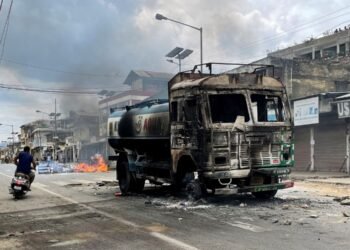The Pacific Ocean roared to life after a massive quake rocked Russia’s Far East, unleashing relentless waves, damaging coastal towns, and sending tsunami warnings across multiple continents.
By PC Bureau
Towering tsunami waves—some reaching a staggering 13 feet (4 meters)—crashed into Russia’s Kuril Islands late Tuesday, July 29, 2025, following a massive 8.8-magnitude earthquake that ruptured the Pacific Ocean floor off the Kamchatka Peninsula. The powerful quake unleashed relentless waves that pummeled coastal communities, triggered widespread evacuations, and sent shockwaves reverberating across the entire Pacific Rim.
In Severo-Kurilsk, the tsunami’s brute force swept away homes and buildings, leaving behind a trail of destruction. “It was like the sea turned into a beast,” said local resident Maria Volkov, who watched helplessly as a kindergarten and nearby houses were engulfed by the rising waters.
The Pacific Tsunami Warning Center (PTWC) reported that the tsunami’s reach was amplified by the quake’s shallow depth, allowing waves to travel across thousands of miles. Coastal regions from Hawaii to Japan remained on high alert.
In Hawaii, waves as high as 4 feet (1.2 meters) were recorded at Kahului, Maui, and Haleiwa, Oahu, with warnings that surges could reach up to 10 feet above normal sea levels. “The ocean came alive, pounding the shore like a hammer,” said Honolulu evacuee Kimo Alvarez, describing the anxiety caused by the fast-moving series of waves. Coastal roads and low-lying neighborhoods across the islands remain at risk of flooding.
🌀 Engineered Fury at the Harbor
📍Severo-Kurilsk, Russia | Chiba, Japan | HawaiiThe narrative of “natural disaster” is wearing thin. As massive tsunami-like waves crash into coasts from Russia’s Severo-Kurilsk to Japan’s Chiba, and now Hawaii the world watches in awe, fear, https://t.co/o1G7iCCb1K pic.twitter.com/kghgAI2MTn
— Aprajita Nafs Nefes 🦋 Ancient Believer (@aprajitanefes) July 30, 2025
In Japan’s Hokkaido region, initial waves measuring up to 40 cm (1.3 feet) were observed, but fears of stronger surges—potentially up to 3 meters (10 feet)—prompted mass evacuations along the Pacific coastline. Authorities have urged residents to stay away from the shore amid ongoing uncertainty about the tsunami’s strength and duration.
The tsunami alert zone extends well beyond Asia. Alaska, California, Guam, Chile, Ecuador, and the Solomon Islands are all on alert, with waves of 1 to 3 meters possible in vulnerable coastal areas. New Zealand also reported significant surges and disruption to marine conditions.
READ: Massive 8.8 Quake Off Russia’s Far East Triggers Tsunami Across Pacific
According to scientists, the sheer energy released by the quake has made this tsunami particularly hazardous. “These waves aren’t just tall—they’re relentless, with the capacity to strike again and again,” warned Dr. Sofia Ivanov, a tsunami expert at the Kamchatka Geophysical Institute.
Compounding the crisis, the tsunami’s threat comes as Tropical Cyclone Co-May batters Shanghai, where over 280,000 people have been evacuated. The dual disasters have stretched emergency services across the Asia-Pacific region.
Search and rescue teams are racing to assess damage and protect lives as the tsunami’s effects continue to unfold. Authorities across the Pacific are urging residents to stay off beaches, avoid coastal zones, and move to higher ground until the all-clear is given. As the ocean’s monstrous power continues to batter shorelines, the world watches anxiously for what may come next.
Other Impacted Regions: Alerts from Alaska to New Zealand
Tsunami warnings were issued across the Pacific Rim, including:
• Alaska: Evacuations in the Aleutian Islands. Tsunami waves between 1–3 meters are possible.
• California, Guam, Ecuador, Chile, and Solomon Islands: On alert for moderate waves and coastal flooding.
• New Zealand: Officials reported disrupted marine activity and strong surges, urging boaters and beachgoers to exercise caution.
• China: In Shanghai, the tsunami threat compounded the chaos of Tropical Cyclone Co-May, prompting the relocation of over 280,000 people.
Experts Warn of Aftershocks and Continued Risk
Scientists at the Kamchatka Geophysical Institute remain on high alert. “These waves are not just high—they’re relentless and capable of striking repeatedly,” said Dr. Sofia Ivanov, a tsunami expert. Aftershocks as strong as magnitude 7.5 are expected over the coming days.
READ: Manipur: Another Hill District Up in Arms Over Absent DC
The U.S. National Weather Service, PTWC, and regional agencies continue to monitor the event. Buoys across the Pacific have confirmed tsunami propagation, and emergency operations remain active across multiple countries.
Emergency Response and Public Safety
• In Hawaii, coastal evacuations remain in effect, and emergency shelters on Hawaii Island and Maui are open.
• Hilo International Airport has suspended all commercial operations to accommodate evacuations and disaster relief.
• In Russia, military and civilian emergency units have been deployed to affected coastal zones for rescue, relief, and assessment.
• In Japan, all maritime and coastal transport services have been temporarily suspended in affected areas.
Public Advisory
Authorities globally are urging residents in at-risk coastal areas to:
• Avoid beaches and low-lying shores.
• Move to higher ground or upper floors of sturdy buildings.
• Remain alert for official updates from local agencies.
At a Glance: Key Impacts by Region
Russia 13-ft tsunami in Kuril Islands; buildings damaged; full evacuation executed.
Hawaii 4-ft waves in Maui & Oahu; shelters open; flights canceled; no injuries yet.
Japan 40 cm waves; mass evacuations ordered; 3m waves feared.
Alaska On alert; coastal evacuations ongoing in Aleutian chain.
New Zealand Marine surges and strong currents reported.
China Tsunami threat overlaps with Cyclone Co-May; 280,000 evacuated in Shanghai.













